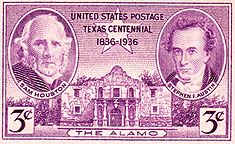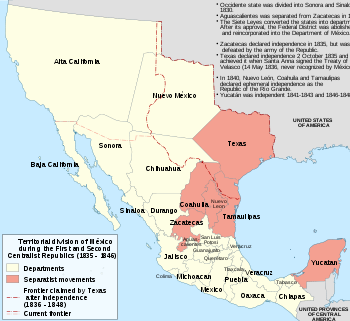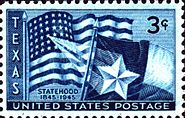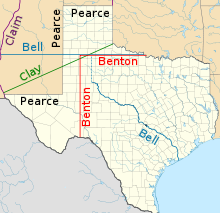- Republic of Texas
-
"Lone Star Republic" redirects here. For the West Florida Lone Star Republic, see Republic of West Florida.
Republic of Texas ← 
1836–1846  →
→

Flag (1839-46) Seal 
Capital Washington-on-the-Brazos 1836 (provisional)
Harrisburg 1836 (provisional)
Galveston 1836 (provisional)
Velasco 1836 (provisional)
Columbia 1836-37
Houston 1837-39
Austin 1839-46Language(s) English (de facto) Spanish, French, German and American Indian languages regionally
Government Republic President1 - 1836-1838 Sam Houston - 1838-1841 Mirabeau B. Lamar - 1841-1844 Sam Houston - 1844-1846 Anson Jones Vice President1 - 1836-1838 Mirabeau B. Lamar - 1838-1841 David G. Burnet - 1841-1844 Edward Burleson - 1844-1845 Kenneth L. Anderson History - Independence from Mexico March 2, 1836 - Annexation by the United States of America December 29, 1845 - Transfer of power February 19, 1846 Area - 1840 1,007,935 km2 (389,166 sq mi) Population - 1840 est. 70,000 Density 0.1 /km2 (0.2 /sq mi) Currency Republic of Texas Dollar ($) 1Interim period (March 16-October 22, 1836): President: David G. Burnet, Vice President Lorenzo de Zavala History of Texas 
This article is part of a seriesTimeline French Texas (1684–1689) Spanish Texas (1690–1821) Mexican Texas (1821–1836) Republic of Texas (1836–1845) Statehood (1845–1860) Civil War Era (1861–1865) Reconstruction and Gilded Age (1865–1899) State of Texas
Texas Portal
The Republic of Texas was an independent nation in North America, bordering the United States and Mexico, that existed from 1836 to 1846.Formed as a break-away republic from Mexico by the Texas Revolution, the state claimed borders that encompassed an area that included all of the present U.S. state of Texas, as well as parts of present-day New Mexico, Oklahoma, Kansas, Colorado, and Wyoming based upon the Treaties of Velasco between the newly created Texas Republic and Mexico. The eastern boundary with the United States was defined by the Adams-Onís Treaty between the United States and Spain, in 1819. Its southern and western-most boundary with Mexico was under dispute throughout the existence of the Republic, with Texas claiming that the boundary was the Rio Grande, and Mexico claiming the Nueces River as the boundary. This dispute would later become a trigger for the Mexican–American War, after the annexation of Texas by the United States.
Contents
History
Establishment
The Republic of Texas was created from part of the Mexican state Coahuila y Tejas as a result of the Texas Revolution. Mexico was in turmoil as leaders attempted to determine an optimal form of government. In 1835, when President Antonio López de Santa Anna abolished the Constitution of 1824, granting himself enormous powers over the government, wary colonists in Texas began forming Committees of Correspondence and Safety. A central committee in San Felipe de Austin coordinated their activities.[1] In the Mexican interior, several states revolted against the new centralist policies.[2] The Texas Revolution officially began on October 2, 1835, in the Battle of Gonzales. Although the Texians originally fought for the reinstatement of the Constitution of 1824, by 1836 the aim of the war had changed. The Convention of 1836 declared independence on March 2, 1836, and officially formed the Republic of Texas.
1836–1845
The first Congress of the Republic of Texas convened in October 1836 at Columbia (now West Columbia). Stephen F. Austin, known as the Father of Texas, died December 27, 1836, after serving two months as Secretary of State for the new Republic.
In 1836, five sites served as temporary capitals of Texas (Washington-on-the-Brazos, Harrisburg, Galveston, Velasco and Columbia), before president Sam Houston moved the capital to Houston in 1837. The capital was moved to the new town of Austin in 1839 by the next president, Mirabeau B. Lamar. The first flag of the republic was the "Burnet Flag" (a gold star on an azure field), followed shortly thereafter by official adoption of the Lone Star Flag.
Internal politics of the Republic were based on the conflict between two factions. The nationalist faction, led by Lamar, advocated the continued independence of Texas, the expulsion of the Native Americans, and the expansion of Texas to the Pacific Ocean. Their opponents, led by Houston, advocated the annexation of Texas to the United States and peaceful co-existence with Native Americans. The Texas Congress even passed a resolution over Houston's veto claiming the Californias for Texas.[3] The 1844 presidential election split dramatically, with the newer western regions of the Republic preferring the nationalist candidate Edward Burleson, while the cotton country, particularly east of the Trinity River, went for Anson Jones.[4]
The Comanches were the main Native American opposition to the Texas Republic. In the late 1830s, Sam Houston negotiated a peace between Texas and the Comanches. Lamar replaced Houston as president in 1838, and reversed the Indian policies. He launched a genocidal war against the Comanches and invaded Comancheria itself. In retaliation, the Comanches attacked Texas in a series of raids. After peace talks in 1840 ended with the massacre of 34 Comanche leaders in San Antonio, the Comanches launched a major attack deep into Texas, known as the Great Raid of 1840. Under command of Potsanaquahip (Buffalo Hump), 500-700 Comanche cavalry warriors swept down the Guadalupe River valley, killing and plundering all the way to the shore of the Gulf of Mexico, where they sacked the towns of Victoria and Linnville. Houston became president again in 1841 and, with both Texans and Comanches exhausted by war, a new peace was established.[5]
Although Texas governed itself, Mexico refused to recognize its independence.[6] On March 5, 1842, a Mexican force of over 500 men, led by Ráfael Vásquez, invaded Texas for the first time since the revolution. They soon headed back to the Rio Grande after briefly occupying San Antonio. About 1,400 Mexican troops, led by the French mercenary general Adrián Woll, launched a second attack and captured San Antonio on September 11, 1842. A Texas militia retaliated at the Battle of Salado Creek.[7] A reinforcement militia, however, was defeated by Mexican soldiers and Texas Cherokee Indians on September 18 during the Dawson Massacre.[8] The Mexican army would later retreat from the city of San Antonio.
Among the effects of Mexico's attacks on Texas was the intensification of conflicts between political factions, including an incident known as the Texas Archive War. To "protect" the Texas national archives, President Sam Houston ordered them removed from Austin. The archives were eventually returned to Austin, albeit at gunpoint. The Texas Congress admonished Houston for the incident, and this episode in Texas history would solidify Austin as Texas's seat of government for the Republic and the future state.[9]
There were also domestic disturbances.The Regulator–Moderator War was a land feud in Harrison and Shelby counties in East Texas from 1839 to 1844. The feud eventually involved Nacogdoches, San Augustine, and other East Texas counties. Harrison County Sheriff John J. Kennedy and county judge Joseph U. Fields helped end the conflict siding with the law and order party. Sam Houston ordered 500 militia to help in ending the feud.
Government
After gaining their independence, the Texas voters had elected a Congress of 14 senators and 29 representatives in September 1836. The Constitution allowed the first president to serve for only two years, and set a three year term for all later presidents.
The first Congress of the Republic of Texas convened in October 1836 at Columbia (now West Columbia). Stephen F. Austin, sometimes called the "Father of Texas," died December 27, 1836, after serving two months as Secretary of State for the new Republic. Due mainly to the ongoing war for independence, five sites served as temporary capitals of Texas in 1836: (Washington-on-the-Brazos, Harrisburg, Galveston, Velasco and Columbia). The capital was moved to the new city of Houston in 1837. In 1839, the capital was moved to a tiny frontier settlement on the Colorado River named Waterloo. A new city was laid out, and Waterloo was renamed Austin.
The court system inaugurated by Congress included a Supreme Court consisting of a chief justice appointed by the president and four associate justices, elected by a joint ballot of both houses of Congress for four-year terms and eligible for re-election. The associates also presided over four judicial districts. Houston nominated James Collinsworth to be the first chief justice. The county-court system consisted of a chief justice and two associates, chosen by a majority of the justices of the peace in the county. Each county was also to have a sheriff, a coroner, justices of the peace, and constables to serve two-year terms. Congress formed 23 counties, whose boundaries generally coincided with the existing municipalities.
In 1839, Texas became the first nation in the world to enact a homestead exemption, under which a person's primary residence could not be seized by creditors.
Boundaries
The Texan leaders at first intended to extend their national boundaries to the Pacific Ocean, but ultimately decided to claim the Rio Grande as boundary, including much of New Mexico, which the Republic never controlled. They also hoped, after peace was made with Mexico, to run a railroad to the Gulf of California to give "access to the East Indian, Peruvian and Chilean trade."[10] When negotiating for the possibility of annexation to the U.S. in late 1836, the Texan government instructed its minister Wharton in Washington that if the boundary were an issue, Texas was willing to settle for a boundary at the watershed between the Nueces River and Rio Grande, and leave out New Mexico.[11]
Diplomatic relations
On March 3, 1837, US President Andrew Jackson appointed Alcée La Branche American chargé d'affaires to the Republic of Texas, thus officially recognizing Texas as an independent republic.[12] France granted official recognition of Texas on September 25, 1839, appointing Alponse Dubois de Saligny to serve as chargé d'affaires. The French Legation was built in 1841, and still stands in Austin as the oldest frame structure in the city.[13] Conversely, the Republic of Texas embassy in Paris was located in what is now the Hotel de Vendome, adjacent to the Place Vendôme in Paris' 2e arrondissement.[14]
The Republic also received diplomatic recognition from Belgium, the Netherlands, and the Republic of Yucatán. The United Kingdom never granted official recognition of Texas due to its own friendly relations with Mexico, but admitted Texan goods into British ports on their own terms. In London, the original Embassy of the Republic of Texas still stands. Immediately opposite the gates to St. James's Palace, Sam Houston's original Embassy of the Republic of Texas to the Court of St. James's is now a hat shop, but is clearly marked with a large plaque and a nearby restaurant is called Texas Embassy.[15] A plaque on the exterior of 3 St. James's Street in London notes that the upper floors of the building (which have housed the noted wine merchant Berry Brothers and Rudd since 1698) housed the Texas Legation.
Presidents and vice presidents
Main article: President of the Republic of TexasPresidents and Vice Presidents of the Republic of Texas with election results From To President Vice president Presidential
candidatesPres.
votesVice pres.
candidatesV.P.
votesMarch 16, 1836 October 22, 1836 David G. Burnet

(interim)Lorenzo de Zavala
(interim)October 22, 1836 December 10, 1838 Sam Houston

Mirabeau B. Lamar Sam Houston
Henry Smith
Stephen F. Austin5119
743
587Mirabeau B. Lamar December 10, 1838 December 13, 1841 Mirabeau B. Lamar

David G. Burnet Mirabeau B. Lamar
Robert Wilson6995
252David G. Burnet December 13, 1841 December 9, 1844 Sam Houston

Edward Burleson Sam Houston
David G. Burnet7915
3619Edward Burleson
Memucan Hunt6141
4336December 9, 1844 February 19, 1846 Anson Jones

Kenneth L. Anderson Anson Jones
Edward Burleson—
—Kenneth L. Anderson Statehood
On February 28, 1845, the U.S. Congress passed a bill that would authorize the United States to annex the Republic of Texas. On March 1, U.S. President John Tyler signed the bill. The legislation set the date for annexation for December 29 of the same year. Faced with imminent American annexation of Texas, Charles Elliot and Alphonse de Saligny, the British and French ministers to Texas, were dispatched to Mexico City by their governments. Meeting with Mexico's foreign secretary, they signed a "Diplomatic Act" in which Mexico offered to recognize an independent Texas, with boundaries that would be determined with French and British mediation. Texas President Anson Jones forwarded both offers to a specially-elected convention meeting at Austin, and the American proposal was accepted with only one dissenting vote. The Mexican proposal was never put to a vote. Following the previous decree of President Jones, the proposal was then put to a national vote.
On October 13, 1845, a large majority of voters in the Republic approved both the American offer and the proposed constitution that specifically endorsed slavery and emigrants bringing slaves to Texas.[16] This constitution was later accepted by the U.S. Congress, making Texas a U.S. state on the same day annexation took effect, December 29, 1845 (therefore bypassing a territorial phase).[17] One of the motivations for annexation was the Texas government had incurred huge debts which the United States agreed to assume upon annexation. As part of the Compromise of 1850, in return for this assumption of debt ($10,000,000), Texas dropped claims to territory, now parts of Colorado, Kansas, Oklahoma, New Mexico, and Wyoming, which Texas had never controlled and which the Federal government had captured directly from Mexico early in the Mexican War and governed directly.
The annexation resolution has been the topic of some historical myths; one that remains is that the resolution granted Texas the explicit right to secede from the Union. This is a right argued by some to be implicitly held by all states, although the Supreme Court of the United States of America ruled in Texas v. White in 1869 that no state has the right to unilaterally secede. The resolution did include two unique provisions: first, it said up to four additional states could be created from Texas' territory, with the consent of the State of Texas (and that new states north of the Missouri Compromise Line would be free states). The resolution did not include any special exceptions to the provisions of the US Constitution regarding statehood. The right to create these possible new states was not "reserved" for Texas, as is sometimes stated.[18] Second, Texas did not have to surrender its public lands to the federal government. While Texas did cede all territory outside of its current area to the federal government in 1850, it did not cede any public lands within its current boundaries. This means the only lands owned by the federal government within Texas have subsequently been purchased by the federal government. This also means the state government has control over oil reserves, which were later used to fund the state's public university system through the Permanent University Fund.[19] In addition, the state's control over offshore oil reserves in Texas runs out to 3 nautical leagues (9 nautical miles, 10.357 statue miles, 16.668 km) rather than three nautical miles (3.45 statue miles, 5.56 km) as with other states.[20] It is also a common fallacy that Texas is the only state that was its own independent entity before it became a U.S. state. This is untrue, as the each of the original Thirteen Colonies was recognized as an independent government prior to federation in 1788. Additionally, the Republic of Vermont was founded as an independent state in 1777, and the government continued in this form until Vermont joined the American Union in 1791. Hawaii also existed as a politically independent state prior to joining the Union, having been governed as an ancient settlement, a Kingdom, a Republic, and finally as a non-state U.S. territory prior to being granted statehood in 1959.
See also
Notes
- ^ Huson 1974, p. 4.
- ^ Lack 1992, p. 7.
- ^ #Fehrenbach, page 263
- ^ #Fehrenbach, page 265
- ^ Hämäläinen 2008, pp. 215–217.
- ^ Jack W. Gunn, "MEXICAN INVASIONS OF 1842," Handbook of Texas Online (http://www.tshaonline.org/handbook/online/articles/qem02), accessed May 24, 2011. Published by the Texas State Historical Association.
- ^ Thomas W. Cutrer, "SALADO CREEK, BATTLE OF," Handbook of Texas Online (http://www.tshaonline.org/handbook/online/articles/qfs01), accessed May 24, 2011. Published by the Texas State Historical Association.
- ^ "Dawson Massacre". Handbook of Texas Online. Retrieved Sep.24, 2006.
- ^ "The Archives War". Texas Treasures- The Republic. The Texas State Library and Archives Commission. 2005-11-02. http://www.tsl.state.tx.us/treasures/republic/archwar/archwar.html. Retrieved 2009-01-03.
- ^ George Rives, The United States and Mexico vol. 1, page 390
- ^ Rives, p. 403
- ^ "LA BRANCHE, ALCÉE LOUIS". Handbook of Texas Online. Retrieved Apr.7, 2010.
- ^ Museum Info, French Legation Museum.
- ^ [1]
- ^ Diplomatic Relations of the Republic of Texas
- ^ http://tarlton.law.utexas.edu/constitutions/text/DART08.html
- ^ The Avalon Project at Yale Law School: Texas - From Independence to Annexation
- ^ Joint Resolution for Annexing Texas to the United States
- ^ Texas Annexation : Questions and Answers, Texas State Library & Archives Commission.
- ^ Overview of U.S. Legislation and Regulations Affecting Offshore Natural Gas and Oil Activity
References
- Huson, Hobart (1974), Captain Phillip Dimmitt's Commandancy of Goliad, 1835–1836: An Episode of the Mexican Federalist War in Texas, Usually Referred to as the Texian Revolution, Austin, TX: Von Boeckmann-Jones Co, http://books.google.com/?id=THI8AAAAIAAJ
- Hämäläinen, Pekka (2008), The Comanche Empire, Yale University Press, ISBN 978-0-300-12654-9, http://books.google.com/?id=Fmh0AAAAMAAJ
- Lack, Paul D. (1992), The Texas Revolutionary Experience: A Political and Social History 1835–1836, Texas A&M University Press, ISBN 0-89096-497-1, http://books.google.com/?id=ZIt5AAAAMAAJ
- Fehrenbach, T. R. (2000), Lone Star: a history of Texas and the Texans, Da Capo Press, ISBN 0306809427, 9780306809422, http://books.google.com/?id=z4x4xEZZ_xsC&pg=PA263
- Republic of Texas Historical Resources
- Republic of Texas from the Handbook of Texas Online
- Hosted by Portal to Texas History:
- Texas: the Rise, Progress, and Prospects of the Republic of Texas, Vol. 1, published 1841
- Texas: the Rise, Progress, and Prospects of the Republic of Texas, Vol. 2, published 1841
- Laws of the Republic, 1836-1838 from Gammel's Laws of Texas, Vol. I.
- Laws of the Republic, 1838-1845 from Gammel's Laws of Texas, Vol. II.
- The Avalon Project at Yale Law School: Texas - From Independence to Annexation
- Early Settlers and Indian Fighters of Southwest Texas by Andrew Jackson Sowell 1900
Further reading
- Hardin, Stephen L.; Wade, Mary Dodson (1998), Lone Star: The Republic of Texas, 1836–1846, Discovery Enterprises, ISBN 9781878668639, http://books.google.com/?id=FjeoPAAACAAJ
- Hogan, William Ransom (2007), The Texas Republic: A Social and Economic History, Texas State Historical Association, ISBN 9780876112205, http://www.worldcat.org/oclc/76167055&referer=brief_results
- Lankevich, George J. (1979), The Presidents of the Republic of Texas: Chronology, Documents, Bibliography, Oceana Publications, ISBN 9780379120851, http://books.google.com/?id=G5RIAAAACAAJ
- Weems, John Edward; Weems, Jane (1971), Dream of Empire: A Human History of the Republic of Texas, 1836-1846, Simon and Schuster, http://books.google.com/?id=GQJ5AAAAMAAJ
History of Texas By period French Texas · Spanish Texas · Mexican Texas · Republic of Texas · Texas in the Civil War · State of Texas
By topic Annexation · Forests · Indian Wars · Jewish history · Oil Boom · Revolution · Slavery · Texas Rangers · Vice
By city Amarillo · Austin · Brownsville · Corpus Christi · Dallas · El Paso · Fort Worth · Galveston · Houston · Laredo · Lubbock · San Antonio
Government agency Texas Historical Commission · Foreign relations of Republic of Texas
Categories:- Former republics
- Former countries in North America
- States and territories established in 1836
- States and territories disestablished in 1846
- Former political entities in North America
- Republic of Texas
- 1845 disestablishments
- Texas Revolution
Wikimedia Foundation. 2010.




